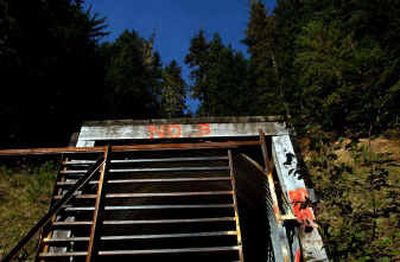Silver Strand Mine could be reopened

The Silver Strand Mine – reportedly discovered by a logger with a pendulum in the 1960s – is about to get a new lease on life from modern prospectors.
New Jersey Mining Co. plans to reopen the small silver mine on the Coeur d’Alene River Ranger District as early as next year. The company’s chief goal is to find out what lies below a 200-foot drift driven by earlier miners.
“It’s sort of an old school Coeur d’Alene district exploration method,” explained Grant Brackebusch, vice president of Kellogg-based New Jersey Mining Co. “We mine it down to see where it takes us … Everybody hopes the grade gets better at depth.”
Small amounts of silver and gold ore were mined from the Silver Strand in the 1970s and 1980s. Brackebusch and his father, New Jersey Mining President Fred Brackebusch, hope to find more.
They’ve proposed a modest program to the U.S. Forest Service: five miners hauling about 1,000 tons of ore from Silver Strand each month. The work would cease in winter, when deep snow covers the narrow canyon.
The Silver Strand lies about 20 miles northeast of Coeur d’Alene. Its history is part of North Idaho’s colorful mining lore.
According to old stories, a logger was driving down a forest road, dangling his mineral-finding pendulum – also known as a doodlebugger – out the window. The pendulum began to sway, pointing the logger to the deposit.
The story “cracks me up, because I’m an engineer,” Grant Brackebusch said.
Doddlebuggers aside, the deposit would have been obvious to anyone with a geology background, he said. Rusty-green rocks denote copper, a sure sign of mineralization.
Higher metals prices sparked Brackebusch’s interest in the Silver Strand. Gold is trading above $400 an ounce, and silver is trading above $6 an ounce. “It’s just starting to look economically feasible,” Grant Brackebusch said.
If the father-son team gets the go-ahead to mine, they’ll be the Silver Strand’s third operators. The mine would also be one of the first permitted on the Idaho Panhandle National Forests in 15 years.
With metals prices rising, “We’re surprised that we haven’t had more interest, given the rich history of this area,” said Dave O’Brien, forest spokesman.
Last month, the Forest Service completed an environmental analysis on the proposed mine plan. The public has until Oct. 15 to submit comments.
The proposed mine would disturb less than three acres. It’s generally considered a low-impact operation, though a partial road closure is likely to draw comment, O’Brien said. The Forest Service proposes closing its Road 411 on weekdays when the mine is in operation.
Forest Service Road 411 runs right by the mine portal. The proximity has led to lots of vandalism, with people shooting the lock off the gate to wriggle inside, Grant Brackebusch said. “For some reason, they all want to get into that dark, dank cavern,” he said.
But the road is also well used by public, judging from the beer cans strewn in its ditches. It’s one of several shortcuts from Fernan to the Coeur d’Alene River drainage.
As a compromise, the district ranger proposed closing the road only on weekdays, to keep people out of the area when drilling and blasting occur. The road would remain open in the winter, when the mine is shut, for snowmobile use.
O’Brien also expects the mine’s water treatment plan to draw public scrutiny. To keep sediment out of nearby Lone Cabin Creek, runoff from the roads, as well as mine wastewater, will be treated. The dirt will settle out of water in tanks, and the water will be sprinkled on nearby forestland.
The water from the mine has slightly higher arsenic levels than the water in nearby creeks. But the arsenic will filter out of the water when it’s applied on the land, so the higher levels don’t reach the ground water, Grant Brackebusch said.
Putting the Silver Strand back in operation will cost about $300,000. New Jersey Mining Co. must also post a $63,000 bond with the Forest Service, insuring that money is available to clean up the site when the mining ends.
The mine plan calls for about five years of operations. But if the exploration is successful, New Jersey could be back, with permit applications for a larger mine.
That’s the hope, Grant Brackebusch said. Satellite images of the area show lots of fault lines. And like rusty green rocks, and perhaps swaying doodlebuggers, they’re indicators of mineralization.
“The potential is what attracted us to this area,” he said.